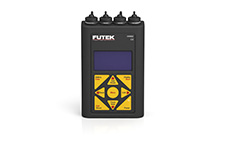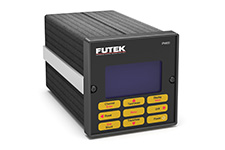Measuring Clamping Force in Bolted Joints
How to ensure safe, accurate torque application with load cells
What Is Clamping Force?
Clamping force is the compressive load generated when a bolt or fastener is tightened—pulling joint members together. It’s not just the torque applied to the bolt that matters, but the resulting preload that holds everything in place. This force is what keeps structures, machines, and critical assemblies—from automotive frames to turbine blades—secure under dynamic service conditions.
Why Measuring Clamping Force Matters
While torque is the most common method to tighten a fastener, it's not always reliable. That’s because friction under the bolt head and in the threads can absorb up to 90% of the applied torque, meaning only a fraction actually becomes clamping force. The result? Two bolts tightened with the same torque can produce drastically different preload values.
Directly measuring clamping force using a load cell helps you:
Validate torque-to-preload consistency across assemblies
Avoid over-tightening or under-tightening
Detect fastener relaxation, loosening, or joint separation
Comply with quality control standards in industries like aerospace, automotive, and heavy machinery
How Load Cells Improve Fastener Testing
To accurately capture clamping force, engineers use thru-hole (donut-style) load cells like FUTEK’s LTH Series, placed directly under the bolt head. Here's what makes this method reliable:
✅ Direct Force Measurement
Unlike torque tools that infer force, load cells measure axial load in real-time—the actual clamping force applied to the joint.
✅ Designed for Precision
FUTEK’s LTH Series features:
Multiple inner diameters to fit various bolt sizes
Compact form factors for inline integration
Hardened washers to minimize surface deformation
✅ Calibration Confidence
Each load cell is calibrated in FUTEK’s A2LA-accredited lab, ensuring traceable, high-accuracy performance. This is critical for repeatable data collection and standard compliance.
This solution is ideal for torque tool calibration and certification, joint design validation through torque versus preload correlation studies, and fastener research and development (R&D) as well as quality assurance processes.
The Role of Friction in Torque Application
Friction significantly affects torque application, often absorbing up to 90% of the applied energy through threads and underhead surfaces. This makes torque an unreliable indicator of true clamping force. FUTEK’s donut load cells address this by directly measuring axial force, bypassing friction-related inaccuracies.
This setup delivers precise, repeatable measurements—ideal for torque tool calibration, preload validation, and fastener quality assurance. It enables engineers to ensure joint integrity with greater accuracy and confidence.
Application Spotlight: Clamping Force in Die Casting
While clamping force measurement is critical across many bolted joint applications, it’s equally essential in metal die-casting operations, where consistent mold clamping plays a pivotal role in process safety and product quality.
Why is it important to measure the clamping force in metal die-casting applications?
Die casting clamping force refers to the force applied to a mold by the clamping unit of the die-casting machine. Using load cells to monitor this force is critical for three key reasons:
Process Integrity: It ensures the mold stays closed during casting, preventing molten metal from leaking and causing safety hazards or part defects.
Equipment Health: Insufficient clamping force may signal worn molds or machine issues, enabling preventive maintenance.
Product Quality: Proper force helps avoid flash, cold shuts, and other casting defects—ultimately improving part consistency and reducing scrap rates.
How it Works
FUTEK’s LTH Series offers several miniature load cells appropriate for this form of force measurement and testing.
In the above application, FUTEK's LTH series load cell is installed between the bolt head and the nut, where it can measure the load as torque is applied. This is one of the best methods on how to how to measure clamping force.
Our engineers recommend including a hardened washer between the load cell and the nut to avoid high friction and maintain flatness on the Thru-Hole during tightening and untightening.
As the operator begins to fasten the bolt, the load cell will measure the bolt clamping force applied (bolt load measurement).
This data can be monitored throughout testing via FUTEK’s IPM650 Panel Mount Display or IHH500 Intelligent Digital Hand Held Display; or it can be streamed to a computer via FUTEK’s USB Solutions.
Operators and engineers can then review this data to verify whether or not they have reached the desired tension or clamp force on the fastener, stud or bolt via SENSIT™ Test and Measurement Software.
FUTEK created an online bolt torque calculator to better assist you.
Overall, the benefits of installing Thru Hole type load cells into your assembly process include: avoiding damage to bearing surfaces, decreasedproblematic tightening of large bolts, ease in untightening, and simultaneous tightening improvements. Still curious on how to measure bolt clamping force? You can read more in our white paper on bolt preload auditing.
Products in Use
Donut/Thru Hole Load Cell (LTH Series) paired with Instrumentation (USB Solutions, IPM650 Panel Mount Display, IHH500 Handheld, or IAA Series Analog Amplifier) suitable for bolt fastening force measurement.
Contact Us
All FUTEK application illustrations are strictly conceptual.
Please Contact Us with questions.
Please Contact Us with questions.
Measuring Clamping Force in Bolted Joints
How to ensure safe, accurate torque application with load cells
What Is Clamping Force?
Clamping force is the compressive load generated when a bolt or fastener is tightened—pulling joint members together. It’s not just the torque applied to the bolt that matters, but the resulting preload that holds everything in place. This force is what keeps structures, machines, and critical assemblies—from automotive frames to turbine blades—secure under dynamic service conditions.
Why Measuring Clamping Force Matters
While torque is the most common method to tighten a fastener, it's not always reliable. That’s because friction under the bolt head and in the threads can absorb up to 90% of the applied torque, meaning only a fraction actually becomes clamping force. The result? Two bolts tightened with the same torque can produce drastically different preload values.
Directly measuring clamping force using a load cell helps you:
Validate torque-to-preload consistency across assemblies
Avoid over-tightening or under-tightening
Detect fastener relaxation, loosening, or joint separation
Comply with quality control standards in industries like aerospace, automotive, and heavy machinery
How Load Cells Improve Fastener Testing
To accurately capture clamping force, engineers use thru-hole (donut-style) load cells like FUTEK’s LTH Series, placed directly under the bolt head. Here's what makes this method reliable:
✅ Direct Force Measurement
Unlike torque tools that infer force, load cells measure axial load in real-time—the actual clamping force applied to the joint.
✅ Designed for Precision
FUTEK’s LTH Series features:
Multiple inner diameters to fit various bolt sizes
Compact form factors for inline integration
Hardened washers to minimize surface deformation
✅ Calibration Confidence
Each load cell is calibrated in FUTEK’s A2LA-accredited lab, ensuring traceable, high-accuracy performance. This is critical for repeatable data collection and standard compliance.
This solution is ideal for torque tool calibration and certification, joint design validation through torque versus preload correlation studies, and fastener research and development (R&D) as well as quality assurance processes.
The Role of Friction in Torque Application
Friction significantly affects torque application, often absorbing up to 90% of the applied energy through threads and underhead surfaces. This makes torque an unreliable indicator of true clamping force. FUTEK’s donut load cells address this by directly measuring axial force, bypassing friction-related inaccuracies.
This setup delivers precise, repeatable measurements—ideal for torque tool calibration, preload validation, and fastener quality assurance. It enables engineers to ensure joint integrity with greater accuracy and confidence.
Application Spotlight: Clamping Force in Die Casting
While clamping force measurement is critical across many bolted joint applications, it’s equally essential in metal die-casting operations, where consistent mold clamping plays a pivotal role in process safety and product quality.
Why is it important to measure the clamping force in metal die-casting applications?
Die casting clamping force refers to the force applied to a mold by the clamping unit of the die-casting machine. Using load cells to monitor this force is critical for three key reasons:
Process Integrity: It ensures the mold stays closed during casting, preventing molten metal from leaking and causing safety hazards or part defects.
Equipment Health: Insufficient clamping force may signal worn molds or machine issues, enabling preventive maintenance.
Product Quality: Proper force helps avoid flash, cold shuts, and other casting defects—ultimately improving part consistency and reducing scrap rates.





